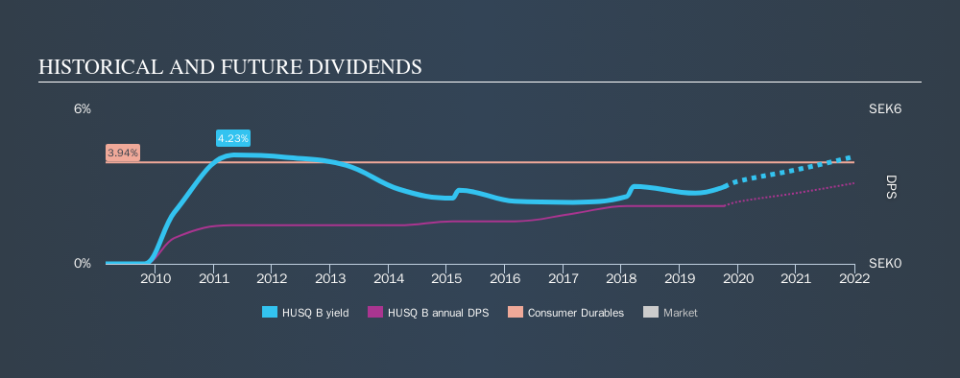Husqvarna AB (publ) (STO:HUSQ B) Stock Goes Ex-Dividend In Just 2 Days

It looks like Husqvarna AB (publ) (STO:HUSQ B) is about to go ex-dividend in the next 2 days. You can purchase shares before the 10th of October in order to receive the dividend, which the company will pay on the 16th of October.
Husqvarna's next dividend payment will be kr1.5 per share, on the back of last year when the company paid a total of kr2.3 to shareholders. Based on the last year's worth of payments, Husqvarna has a trailing yield of 3.0% on the current stock price of SEK75.22. We love seeing companies pay a dividend, but it's also important to be sure that laying the golden eggs isn't going to kill our golden goose! So we need to check whether the dividend payments are covered, and if earnings are growing.
See our latest analysis for Husqvarna
Dividends are typically paid out of company income, so if a company pays out more than it earned, its dividend is usually at a higher risk of being cut. Its dividend payout ratio is 84% of profit, which means the company is paying out a majority of its earnings. The relatively limited profit reinvestment could slow the rate of future earnings growth We'd be concerned if earnings began to decline. That said, even highly profitable companies sometimes might not generate enough cash to pay the dividend, which is why we should always check if the dividend is covered by cash flow. Over the last year, it paid out more than three-quarters (84%) of its free cash flow generated, which is fairly high and may be starting to limit reinvestment in the business.
It's encouraging to see that the dividend is covered by both profit and cash flow. This generally suggests the dividend is sustainable, as long as earnings don't drop precipitously.
Click here to see the company's payout ratio, plus analyst estimates of its future dividends.
Have Earnings And Dividends Been Growing?
Businesses with strong growth prospects usually make the best dividend payers, because it's easier to grow dividends when earnings per share are improving. If business enters a downturn and the dividend is cut, the company could see its value fall precipitously. Fortunately for readers, Husqvarna's earnings per share have been growing at 11% a year for the past five years. The company paid out most of its earnings as dividends over the last year, even though business is booming and earnings per share are growing rapidly. Higher earnings generally bode well for growing dividends, although with seemingly strong growth prospects we'd wonder why management are not reinvesting more in the business.
The main way most investors will assess a company's dividend prospects is by checking the historical rate of dividend growth. Since the start of our data, nine years ago, Husqvarna has lifted its dividend by approximately 9.4% a year on average. We're glad to see dividends rising alongside earnings over a number of years, which may be a sign the company intends to share the growth with shareholders.
The Bottom Line
Is Husqvarna worth buying for its dividend? Higher earnings per share generally lead to higher dividends from dividend-paying stocks over the long run. That's why we're glad to see Husqvarna's earnings per share growing, although as we saw, the company is paying out more than half of its earnings and cashflow - 84% and 84% respectively. It might be worth researching if the company is reinvesting in growth projects that could grow earnings and dividends in the future, but for now we're not all that optimistic on its dividend prospects.
Wondering what the future holds for Husqvarna? See what the six analysts we track are forecasting, with this visualisation of its historical and future estimated earnings and cash flow
We wouldn't recommend just buying the first dividend stock you see, though. Here's a list of interesting dividend stocks with a greater than 2% yield and an upcoming dividend.
We aim to bring you long-term focused research analysis driven by fundamental data. Note that our analysis may not factor in the latest price-sensitive company announcements or qualitative material.
If you spot an error that warrants correction, please contact the editor at editorial-team@simplywallst.com. This article by Simply Wall St is general in nature. It does not constitute a recommendation to buy or sell any stock, and does not take account of your objectives, or your financial situation. Simply Wall St has no position in the stocks mentioned. Thank you for reading.

